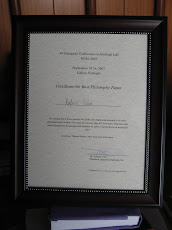The roundabout case study
The goal is to have multiple robots developing activities in a shared environment with human, in such a way that humans can interact with robots "naturally", intuitively, without a need to learn specific techniques to deal with them. The focus is not one-to-one interaction, but social behaviour in physical and social environments populated with many natural as well as artificial agents. So, the robots must be able to recognize institutions and institutional indicators that humans also recognize as structuring forms of their complex social relationships. This includes, for instance, rules, routines, signs, forms of organization of the material world, social roles, and social forms as organizations or teams.
References:
SILVA, Porfírio, and LIMA, Pedro U., "Institutional Robotics", in Fernando Almeida e Costa et al. (eds.), Advances in Artificial Life. Proceedings of the 9th European Conference, ECAL 2007, Berlim e Heidelbergh, Springer-Verlag, 2007, pp. 595-604 link
SILVA, Porfírio, VENTURA, Rodrigo, and LIMA, Pedro U.,"Institutional Environments", in Proc. of Workshop AT2AI: From agent theory to agent implementation, AAMAS 2008 - 7th International Conference on Autonomous Agents and Multiagent Systems, Estoril, Portugal, 2008 link
The roundabout case study
To put to a first test some of the basic concepts of Institutional Robotics, there is an ongoing case study with a minimalist setting. We want a set of robots to become able to behave as car drivers in an urban traffic scenario. The minimal setup represents several roundabouts connected by a small system of streets. Robots will have to know how to deal with basic aspects of the road code, some traffic signs, and agents playing special roles (police robots). Some more general rules, typical of human societies (“respect the integrity of other agents”, for example) must also be acknowledged and respected by the robots. Teams of e-pucks (the small robots being used) should be able to act in a “normal”, “conformist” way in the institutional environment while competing for the realization of a particular task (for example, collecting energy). But the robots could also be able, guided by utility-based considerations, to opt for inobservance of the institutional framework. The experiment will address the consequences of that co-existence of "conformist" and "non-conformist" behaviours within the same “robotic society”.
The case study explores an aspect that is essential in many institutions. Most of the time, institutions have both material and mental aspects. The roundabout in a traffic scenario instances that property. On the one hand, the roundabout, just due to its physical features, constrains behaviour: vehicles can not move on, drivers must choose either to turn right or to turn left if they want to proceed. Now, doing that (deciding in a conformist way, in Portugal, to go right) implies invoking a mental entity, a rule. It is well known that this rule is not the same in all countries. But it always combines with material features of the roundabout to play its role in a institutional environment.
 Part of the experimental setup
Part of the experimental setupat Researchers’ Night 2008 (26th September 2008, Centro Cultural de Belém)
 A step of the experiment ahead
A step of the experiment aheadBasic behaviours: obstacles avoidance, wall following.
Cognitions does not preclude emergence: one e-puck got stuck on a small elevation; another robot, just passing through, and not being aware of the situation, smooths down the elevation with its own weight and frees its fellow.
(José Nuno Pereira, at ISR/IST, is a crucial participant in the roundabout case study.)



